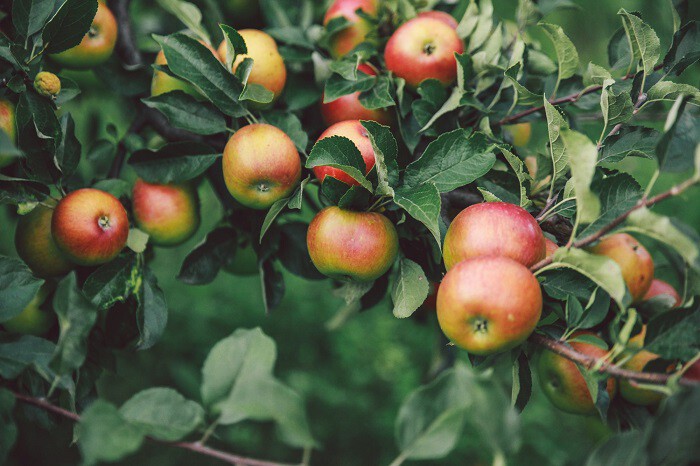When you see foliage that appears to be rolling up, a few different issues could be the cause. For most of them, you can set things right again with these tips.

Apple trees often have an overall appearance of abundance, from spring blossoms to summer fruit and leaves turning bright colors in the fall. But if the foliage starts changing color and curling before fall, though, you've got trouble on your hands. Lovely as they are, apple trees are not a plant-it-and-forget-it addition to your garden. That's because lots of insect pests love them and these plants are prone to getting several diseases. Years of beauty and juicy fruit still can be yours, but keeping your apple tree healthy and full of fruit takes regular maintenance. Here's what to watch out for and how to deal with it.
Your apple tree has three kinds of enemies: Fungal diseases, bugs, and bacteria. If you see the apple leaves curling, one of these is the culprit. Snip off a few of the unhealthy leaves and study them, looking for any powder or stickiness on the top or the underside of the leaf. You might even see small insects. Identifying which of the big three apple problems you're seeing is the first step to restoring your tree to health.
Fungal Diseases on Apple Trees
While apple trees are susceptible to several fungal diseases, there are two very common ones that can cause leaf curling. The good news is that a little routine maintenance can keep them at bay.
Powdery Mildew
Powdery mildew looks like it sounds: White powder on the leaves of your apple tree. If it sticks around very long, those leaves will start to shrivel, so grab your hose and blast that powder off with water. If the powdery mildew comes back, then spray with a copper fungicide. Prevention: Prune branches to keep good air circulation going.
Apple Scab
This fungus flares up after rainy weather, making yellow or dark speckles and blotches on leaves. The leaves can twist, and eventually, the leaves will yellow and fall off. The hose trick won't work this time because scab thrives in moisture; you have to go straight to the fungicide spray and cover all the leaves and fruit. Prevention: Practice what farmers call "good orchard hygiene" by picking up fallen leaves and fruit and putting them in the trash, not the compost.
Pests That Attack Apple Trees
Keep an eye out for these pests; they're the most likely to invade your apple trees.
Aphids
Aphids are tiny white or green insects you'll notice on the undersides of the leaves. They create a sticky "honeydew" and that can encourage a dark covering of sooty mold. If you're lucky, ladybugs will show up to get rid of your aphid visitors (each ladybug can eat 50 aphids a day) so don't spray with a pesticide just yet. If there are only a few leaves under attack, you can simply prune them off and throw them in the garbage. If you have more than a few leaves involved, squirt the whole tree with a hard spray from the hose. Aphids won't do permanent harm to the apple tree, but if it seems like a big invasion you can spray with insecticidal soap or horticultural oil.
Leaf Rollers
As industrious as they sound, leaf rollers spend their busy larval lives rolling up the apple tree leaves and tying them in silk thread. They don't just roll the leaves, they munch on them too. Peer inside the rolls and you may see these green or yellow worms hiding in their shelters. Spraying with water or another liquid will knock them out, but you have to be sure to get the spray inside the rolled leaves. Start with the hose spray and if they live on, go to an insecticidal soap or horticultural oil spray.
Bacteria That Harm Apple Trees
Bacteria can be a little trickier to spot than fungal diseases or pests, but there's one main troublemaker you should look out for.
Fire Blight
The name says it all because your apple leaves will get a scorched, dried look as they curl. Prune out any withered branches in your tree. Spraying will not help as much by the time you see leaf damage, but check with your local Master Gardeners about using Serenade Optimum, copper or Bordeaux mixture. Prevention: The fire blight bacteria live through the winter in the tree bark, so check in spring to see if there are oozing spots on the bark and spray promptly to stop the bacteria before they infect more of your tree.
Plant Disease-Resistant Apple Trees
When adding an apple tree to your garden, scout out the disease-resistant trees that do best in your climate. Planting a disease-resistant apple tree means less messing around with sprays in the years ahead.